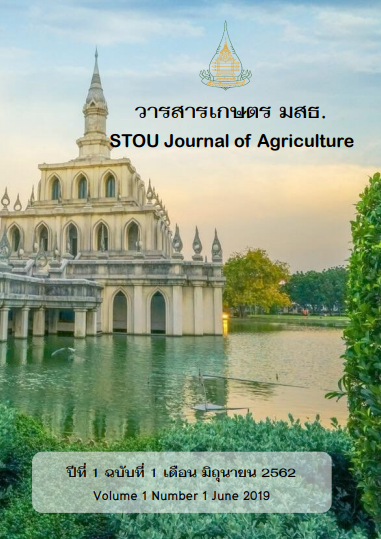การใช้สารลีโอนาร์ไดต์ดัดแปลงสำหรับการปลูกผักบุ้งจีนในดินเหนียว
Main Article Content
บทคัดย่อ
การวิจัยนี้มีวัตถุประสงค์เพื่อศึกษาผลของการใช้สารลีโอนาร์ไดต์ดัดแปลงที่มีผลต่อการเจริญเติบโตและผลผลิตของผักบุ้งจีนที่ปลูกในดินเหนียว วางแผนการทดลองแบบสุ่มสมบูรณ์ภายในกลุ่ม หน่วยการทดลองคือ ต้นผักบุ้งจีนที่ปลูกในแปลงขนาดกว้าง 2 เมตร x ยาว 1 เมตร จำนวนซ้ำ 3 ซ้ำ และทรีตเมนต์ 3 ทรีตเมนต์ ทรีตเมนต์ที่ 1 คือ ไม่ใช้สารผสมลีโอนาร์ไดต์ดัดแปลง ทรีตเมนต์ที่ 2 คือ ใช้สารผสมลีโอนาร์ไดต์ดัดแปลง อัตรา 2.5 ตันต่อไร่ ทรีตเมนต์ที่ 3 คือ ใช้สารผสมลีโอนาร์ไดต์ดัดแปลง อัตรา 5.0 ตันต่อไร่ วิเคราะห์ความแปรปรวนของข้อมูล และเปรียบเทียบความแตกต่างทางสถิติด้วยวิธี Duncan’s new multiple range test ที่ระดับความเชื่อมั่น 95 เปอร์เซ็นต์ ทำการทดลองที่ตำบลบางเดื่อ อำเภอเมืองปทุมธานี จังหวัดปทุมธานี พบว่า ผักบุ้งจีนรุ่นที่ 1 อายุ 7, 14 และ 21 วันหลังปลูก มีความสูงต้น จำนวนใบ และผลผลิตรวมไม่มีความแตกต่างกันทางสถิติ (P> 0.05) แต่ผักบุ้งจีนที่ได้รับสารลีโอนาร์ไดต์ดัดแปลงอัตรา 5 ตันต่อไร่ เมื่อผักบุ้งจีนอายุ 7 วันหลังปลูก มีเส้นผ่านศูนย์กลางลำต้นมากที่สุด (p<0.05) ผักบุ้งจีนอายุ 14 วันหลังปลูก มีน้ำหนักสดต้นมากที่สุด (p<0.05) และผักบุ้งจีนอายุ 21 วันหลังปลูก มีน้ำหนักสดและแห้งต้นมากที่สุด (p<0.05) ผักบุ้งจีนรุ่นที่ 2 อายุ 7, 14 และ 21 วันหลังปลูก มีความสูงต้น และเส้นผ่านศูนย์กลางลำต้นไม่แตกต่างกัน (P> 0.05) ผักบุ้งจีนที่ได้รับสารลีโอนาร์ไดต์ดัดแปลงอัตรา 5 ตันต่อไร่ หลังปลูก มีน้ำหนักสดและแห้งต้นมากที่สุด (p<0.05) เมื่อผักบุ้งจีนอายุ 7 วัน นอกจากนี้ผักบุ้งจีนอายุ 14 วันหลังปลูก มีน้ำหนักสดต้นมากที่สุด (p<0.05) และผักบุ้งจีนอายุ 21 วันหลังปลูก มีจำนวนใบและน้ำหนักสดต้นมากที่สุด (p<0.05) และผลผลิตรวมมากที่สุด (p<0.01)
Article Details
บทความที่ได้รับการตีพิมพ์เป็นลิขสิทธฺ์ของวารสารเกษตร มสธ.
ข้อความที่ปรากฎใน
เอกสารอ้างอิง
คณาจารย์ปฐพีวิทยา. (2544). ปฐพีวิทยาเบื้องต้น. กรุงเทพฯ: สำนักพิมพ์มหาวิทยาลัยเกษตรศาสตร์.
จักรพันธ์ อินทจักร. (2555). การใช้สารลีโอนาร์ไดต์เพื่อปรับปรุงคุณภาพปุ๋ยหมักและผลผลิตคะน้า. (วิทยานิพนธ์ปริญญามหาบัณฑิต). มหาวิทยาลัยเชียงใหม่, เชียงใหม่.
ณธรรศ สมจันทร์ และอรวรรณ ฉัตรสีรุ้ง. (2557). การปรับปรุงคุณภาพลีโอนาร์ไดต์สำหรับเป็นวัสดุปรับปรุงดิน. วารสารวิจัยและพัฒนา มจธ. 37(1), 33-43.
ภาสินี สืบสวน, ศรัณย์ สืบกระแสร์, ศตวรรษ บุญมี และสุกัญญา แย้มประชา. (2560). ผลของการใช้ลีโอนาร์ไดต์และปุ๋ยมูลโคต่อการเจริญเติบโต ผลผลิตของดอกดาวเรือง และการเปลี่ยนแปลงสมบัติของดินหลังปลูก. ใน: รายงานการประชุมวิชาการดินและปุ๋ยแห่งชาติ ครั้งที่ 5 ขับเคลื่อนนวัตกรรมด้ารดินและปุ๋ย ก้าวสู่...เกษตร 4.0. วันที่ 1-2 สิงหาคม 2560. โรงแรมเซ็นทราบาย เซ็นทารา ศูนย์ราชการและคอนเวนชั่นเซ็นเตอร์ แจ้งวัฒนะ กรุงเทพฯ.
วิวัฒน์ โตธิรกุล, พลยุทธ ศุขสมิติ และจินดารัตน์ โตกมลธรรม. (2552). การเตรียมสารประกอบเกลือฮิวเมตจากดินปนถ่านหินจากเหมืองลิกไนต์แม่เมาะ จังหวัดลำปาง. (รายงานผลการวิจัย) เชียงใหม่: สำนักงานอุตสาหกรรมพื้นฐานและการเหมืองแร่เขต 3 (ภาคเหนือ) กรมอุตสาหกรรมพื้นฐานและการเหมืองแร่ กระทรวงอุตสาหกรรม.
สุมณฑา ม่วงศรี, ปริชาติ ดิษฐกิจ และสัจจา บรรจงศิริ. (2562). ผลของลีโอนาร์ไดต์ดัดแปลงต่อการเจริญเติบโตและผลผลิตของผักกาดหอมที่ปลูกในดินเหนียว. (การศึกษาค้นคว้าอิสระปริญญามหาบัณฑิต). มหาวิทยาลัยสุโขทัยธรรมาธิราช นนทบุรี.
สุรินทร์ รินณรงค์, อัจฉรา จิตตลดากร และพงศ์พันธุ์ เธียรหิรัญ. (2559). ผลของลีโอนาร์ไดต์ต่อการเจริญเติบโตและผลผลิตของผักกวางตุ้ง. ใน: รายงานการประชุมเสนอผลงานวิจัยระดับชาติ มหาวิทยาลัยสุโขทัยธรรมาธิราช ครั้งที่ 6 วันที่ 25 พฤศจิกายน 2559. มหาวิทยาลัยสุโขทัยธรรมาธิราช จังหวัดนนทบุรี.


